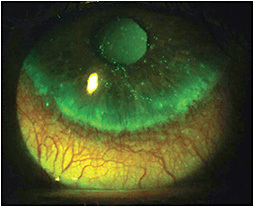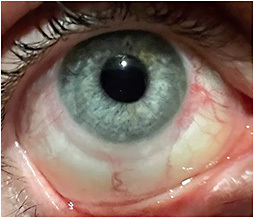
SCLERAL LENSES (SLs) are available in a wide range of overall diameters (OADs), giving practitioners the ability to treat a variety of ocular conditions. As SLs are designed to vault the cornea and limbus and land on the conjunctiva, the patient’s ocular anatomy—namely palpebral fissure size, horizontal visible iris diameter (HVID), and corneal sagittal height—should be considered when determining an adequate OAD (van der Worp, 2015).
These large lenses can be daunting for patients and practitioners alike. Practitioners may find that scleral shape asymmetry increases as they land further beyond the limbus (Ritzmann et al, 2018) and achieving scleral alignment often requires a highly customized quadrant-specific landing zone (DeNaeyer et al, 2017). Apprehensive patients may voice concern as handling continues to be the most cited reason for SL cessation (Macedo-de-Araújo et al, 2020). It may be tempting to circumnavigate these issues by utilizing a smaller OAD; however, the following are a few signs that you may have gone too small.
1. Persistent Limbal Bearing Persistent bearing on the limbus can lead to serious complications such as vascularization and limbal stem cell deficiency (Walker et al, 2016). Patients may report ocular irritation, injection, and decreased wear time while practitioners may see a circumferential ring of paralimbal staining (Figure 1).

Many contemporary SL designs can increase or decrease limbal clearances by steepening or flattening the curves in the transition (a.k.a. limbal zone) (Figure 2).

If poor limbal clearance continues despite changes to the transition zone, consider increasing the lens optical zone or widening the transition curves. The transition-landing zone junction may be occurring within or even prior to the limbus, thus the desired effects of limbal zone steepening are not visible. Increasing the optic zone or transition curve widths pushes the transition-landing zone junction outwards and increases SL sagittal depth at the same time.
2. Persistent Rebound Conjunctival Injection or Deep Compression Rings Consider increasing SL OAD if conjunctival hyperemia or compression rings (Figure 3) persist despite circumferential edge alignment and gentle lens application techniques. The weight of the SL is supported by the tear fluid reservoir and scleral conjunctiva. Typically, SLs with greater sagittal depths require a larger OAD with a widened landing zone portion. By widening the landing zone curves, the weight is distributed over a larger surface area and prevents conjunctival compression—like a snowshoe versus a stiletto heel (DePaolis, 2009). Patients who experience excessive lens settling secondary to an insufficient landing zone may report good initial comfort that decreases with increased wear time.

Selecting a proper SL OAD is a delicate act of balancing ocular anatomical restrictions, patient needs, and realistic lens handling capabilities. CLS
References
- van der Worp E. A Guide to Scleral Lens Fitting (2 ed.) Monographs, Reports, and Catalogs. 2015 May. Available from commons.pacificu.edu/mono/10 .
- Ritzmann M, Caroline PJ, Börret R, Korszen E. An analysis of anterior scleral shape and its role in the design and fitting of scleral contact lenses. Cont Lens Anterior Eye. 2018 Apr;41:205-213.
- DeNaeyer G, Sanders D, van der Worp E, Jedlicka J, Michaud L, Morrison S. Qualitative Assessment of Scleral Shape Patterns Using a New Wide Field Ocular Surface Elevation Topographer: The SSSG Study. JCLRS [Internet]. 2017 Nov. Available at jclrs.org/index.php/JCLRS/article/view/11 .
- Macedo-de-Araújo RJ, van der Worp E, González-Méijome JM. A one-year prospective study on scleral lens wear success. Cont Lens Anterior Eye. 2020 Dec;43:553-561.
- Walker MK, Bergmanson JP, Miller WL, Marsack JD, Johnson LA. Complications and fitting challenges associated with scleral contact lenses: A review. Cont Lens Anterior Eye. 2016 Apr;39:88-96.
- Michaud L, Lipson M, Kramer E, Walker M. The official guide to scleral lens terminology. Cont Lens Anterior Eye. 2020 Dec;43:529-534.
- DePaolis M, Shovlin J, DeKinder JO, Sindt C. Postsurgical contact Lens fitting. Clinical Manual of Contact Lenses. 2009;19:508-541.



